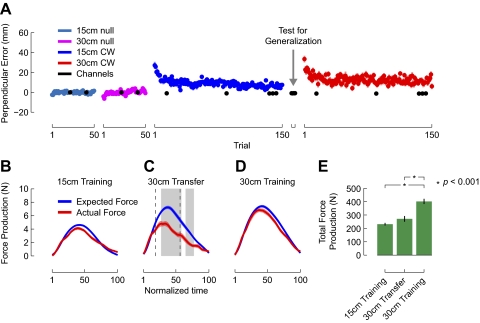Fig. 2.
Movement kinematics and force production for an increase in movement amplitude. A: on every trial we measured the maximum deviation from a straight line linking movement start and end [perpendicular error (PE)]. Datapoints give mean ± SE. On a per subject basis, data for each movement amplitude have been normalized relative to mean baseline performance for the 15 (cyan) and 30 cm (pink) targets. The force field resulted in curvature on initial 15 cm movements that was eliminated with training (blue). After the test for generalization to the 30 cm target, the force field resulted in some curvature, but less than shown by naïve subjects who had no previous experience with the force field (see Fig. 4A). This curvature was eliminated over the course of training (red). Curvature on channel trials was held at near-0 values (black). B: at the end of training on the 15 cm target, lateral forces that were actually produced (red) were no different from the forces that would have been required to compensate for the force field (blue). Each curve represents the mean ± SE time-normalized force record. C: during the test for generalization on the 30 cm target, actual force was less than expected. The gray band indicates where the curves are reliably different according to functional ANOVA (fANOVA). The range over which actual force was less than expected corresponds to the range of the movement where velocity was greater than velocities experienced during training. This range is given by the dashed vertical lines. D: at the end of training on the 30 cm target, subjects produced forces that fully compensated for the force field. This indicates that the failure to generalize shown in C is not caused by a general inability to produce the appropriate forces on the 30 cm target. E: a repeated-measures ANOVA shows that actual lateral force production at the end of training on the 15 cm target was no different from during the test for generalization. For each subject, we computed the area beneath the actual lateral force profiles. The bars give mean ± SE for the 3 channel movements.

